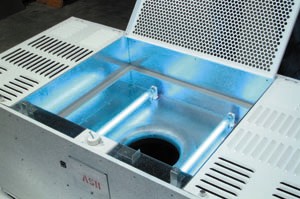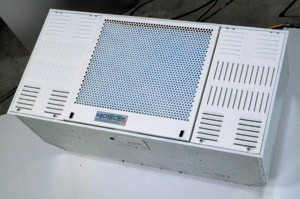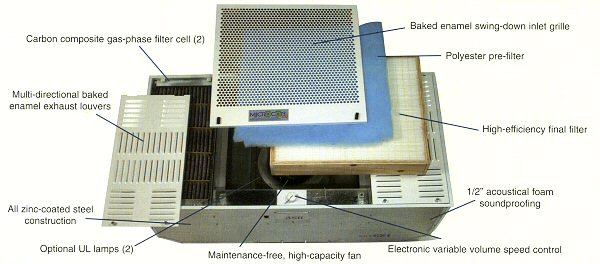|
Toll Free: 800-224-9768 Email us
|
Biological Controls - Eatontown NJ
Manufacturers of Quality Air Purification Systems and Air Quality
Solutions Since 1973
Indoor Air Quality (IAQ) Control and Air Purification
for Police Evidence Rooms & Property Rooms:
Health Concerns - Safety Issues - Health Hazards
Evidence Room Clean Air and Good Evidence Room Design -
Aspergillus Mold - Aspergillus Mold Spores
|
 Police evidence room and property room technicians should be aware of health concerns, safety concerns, and potential health hazards associated with their work environments. Compliance with the Safety Standards and Precautions issued by NIOSH and IAPE International Association of Property & Evidence is highly recommended. See Resources (bottom of this page). Police evidence room and property room technicians should be aware of health concerns, safety concerns, and potential health hazards associated with their work environments. Compliance with the Safety Standards and Precautions issued by NIOSH and IAPE International Association of Property & Evidence is highly recommended. See Resources (bottom of this page).

|
|
| Evidence Room - Health Concerns (Click Here for More Info) |
 Cramped, poorly ventilated areas sometimes situated in windowless basements, filled and crammed with boxes and bags of stored evidence could pose a long term health threat. Providing clean air is the solution. Cramped, poorly ventilated areas sometimes situated in windowless basements, filled and crammed with boxes and bags of stored evidence could pose a long term health threat. Providing clean air is the solution.
Poor Indoor Air Quality especially within your “breathing zone” being dry, musty, stale, dusty, stagnant, smelly, having foul odors and accompanied by dirt , soot, mold spores, bacteria, and dust mites. Does this describe the space where you breathe and work? Fugitive odors, contaminants, and pollutants caused by poor ventilation, inadequate air changes, or insufficient filtration coupled with inconsistent housekeeping procedures produces poor air quality results. |
| MICROCON® CD with Germicidal UV |
Features
 |
99.7%
efficiency on sub-micron particles |
 |
Progressive
filtration system |
 |
Controls
both airborne participate
and gas-phase pollutants |
 |
Mounts
flush with ceiling |
 |
Multidirectional
exhaust louvers |
 |
Baked
on white enamel finish |
The
MICROCON CD is a ceiling
mounted air filtration system that is specifically
designed for the removal of both airborne pollutants
and gaseous contaminants from indoor environments.
Placed in a standard 2' x 4' T-bar ceiling channel,
air is drawn through the center grille section,
prefiltered, and final filtered before being
exhausted through two carbon filter cells. Clean
air, free
of particulate and gaseous odors, is reintroduced
to the room. Air changes, filtration, dilution
and gas phase contaminant removal will provide
a healthier environment.

MICROCON® CD with HEPA filter
removed to show optional UV
lamps
Ultraviolet (Ultra Violet)
Ultraviolet germicidal (UV) radiation
in the 254-nanometer
wavelength has proven effective
in killing most types of airborne
bacteria and viruses. Coupled
with a high efficiency filter
cell upstream
of the two UV lamps the germicidal
effectiveness is greatly enhanced.
The addition of the UV lamps
to the MICROCON® CD provides
for a "total
air quality solution" for
just about any indoor environment.
|
 .
.
Filtration:
The MICROCON® CD is a three-stage progressive filtration system. The first stage is a 1" thick synthetic pre-filter designed to contain larger size airborne particles thereby extending the life of the final filter.
The secondary or
final filter is a hospital-grade, high-efficiency
pleated filter cell capable of removing virtually
100% of airborne particles in the sub-micron range.
Since removal of gas phase pollutants require a
different capture mechanism - carbon or charcoal,
a unique carbon composite cell is utilized as the
last stage which allows for higher adsorbent loading
at a lower pressure drop than comparable carbon
cells.

Performance:
The MICROCON®
CD delivers up to 1000 cfm of filtered air at varying
speeds. For example, in a room that measures 20X20t,
with an eight-foot ceiling, over 18 air changes per
hour can be achieved or one air change every 3.5 minutes.
Exhaust louvers are
positioned to channel filtered exhaust air in four
different directions to provide for good air dispersion
and mixing within a room. Air quality improvement
will result by maximizing the air movement and
creating airflow patterns throughout the room.
The entire exhaust plenum interior is lined with
foam soundproofing material to further reduce sound
levels. |

| Product
Details (click link) |
|
Please
feel free to download our whole catalog so you can print
this out and have your own personal copy.
Click download to begin downloading a copy of our products catalog.
Three Filtration Levels
| Model No. |
Model |
Filters |
| MCD-002 |
Microcon CD |
Pre-Filter, Final Filter, Carbon Cells (2) |
| MCDH-002 |
Microcon CD HEPA |
Pre-Filter, Final Filter, Carbon Cells (2) |
| MCDHUV-003 |
Microcon CD HEPA UV |
Pre-Filter, Final Filter, Carbon Cells UV Lamps (2) |
|
| Why the MICROCON CD Offers the Best Filtration Choice |
The MICROCON CD is a three-stage progressive filtration system. The first stage is a 1” thick synthetic pre-filter designed to contain larger size airborne particles thereby extending the life of the final filter. The secondary or final filter is a hospital grade, high efficiency pleated filter cell capable of removing virtually 100% of airborne particles in the sub-micron range. Since removal of gas phase pollutants requires a different capture mechanism – carbon or charcoal, a unique carbon composite cell is utilized as the last stage which allows for higher adsorbent loading at a lower pressure drop than comparable carbon cells.
|
| Gas Phase Filtration: Why Our DPCC Cell Has it All Over Traditional Bulk Carbon Trays |
The MICROCON CD air purifier utilizes a unique type of gas phase adsorber. The DPCC (Dry Process Carbon Composite) cell is a new type of filtration technology for the removal of low level gas phase pollutants from a diverse range of indoor air environmental conditions. The DPCC cell is a fabric/composite based adsorber designed around a new carbon technology that reduces weight by as much as 75%. The unit has the capacity to trap high area surface sorbents in it's fiber matrix while experiencing no reduction in service life.
Our sorbent-based absorber functions on the principal of diffusion. A process whereby an area of high concentration of gas phase pollutants moves to an area of low concentration.
The DPCC matrix is a dry process that takes very fine particles of base carbon and introduces them into a fiber mat structure, creating a greatly enhanced surface area, free of structural voids. Through thermal activation the various components are bonded together. The resulting composition of a fabric structure features very fine sorbent particles physically and thermally bonded to surrounding fibers. Bulk carbon or traditional carbon absorbers are loose granules poured or spread into trays or upright open panels. The DPCC carbon adsorber uses a fraction of the carbon weight of traditional bulk carbon systems, while maintaining comparable performance. The DPCC cell doesn't cause “dusting” while in use, a common trait of loose granular carbon cells. The natural tendency for granules vibrating in an airstream is to settle. This settling causes gaps in the sorbent allowing untreated air to bypass the system. The DPCC carbon doesn't settle because the sorbent is integrated into the fabric/composite matrix, offering many operational benefits such as effectively removing formaldehyde, acid gases and hydrocarbons. While size and weight have been reduced, performance is maintained and enhancing all at a distinct cost and performance advantage.
|
Are You Ready to Take the First Step and Provide Clean Air Through Air Purification? |
Biological Controls - MICROCON® Air Purifier creates a clean air, safe environment by clearing particulate, infectious air, and VOCs (Volatile Organic Compounds) from the room, as well as dirt, dust, soot, mold spores, bacteria, dust mites and animal dander. MICROCON® eliminates infectious airborne pathogens, and removes hazardous microbial airborne particulate. Including the potential hazardous bacteria introduced into the air from infected persons from whence the evidence was retrieved. These are invisible to the naked eye and can remain suspended in the air stream indefinitely. MICROCON® with HEPA Filtration captures particulate like bacteria, as small as .3 microns in size and with the UV lamps added can irradiate viruses even smaller in the angstrom range.
For safety reasons as well as security concerns some evidence storage requires containment in a negative air pressure environment. MICROCON® MCDHUV is used in highly sensitive environments to avert migration of potentially dangerous airborne particulate from seized drugs that could become contaminated and rendered unusable for evidence. It protects employees from airborne contaminants such as dried blood borne pathogens introduced into the air from stored clothing and soiled garments, lead dust from weapon storage and drug off-gassing thereby creating the potential for various health issues.
The MICROCON® MCDHUV - Air Purification System meets requirements for law enforcement organizations, and US government agencies.
Email or call 1.800.224.9724 and Consult our Biological Controls sales technicians for solutions to your indoor air quality problems.
|
|
| DUST- A Health Issue a Health Concern and a Health Hazard (if not controlled) |
|
 |
Dust can be a troublesome addition in evidence rooms. Necessary and needed air purification with HEPA Filtration will protect the evidence room staff from potential air pollutants which could make them ill and possibly cause various Sinus diseases and infections e.g. Acute Sinusitis, Chronic Sinusitis, and Lung pulmonary infection of contagious diseases.
Snippets from the EPA on Allergic Reactions:
A major health concern and health issue associated with exposure to biological pollutants is allergic reactions, which range from rhinitis, nasal congestion, conjunctival inflammation, and urticaria to asthma. Notable triggers for these diseases are allergens derived from house dust mites;
|
The role of mites as a source of house dust allergens has been known for over 30 years.. It is now possible to measure mite allergens in the environment and large antibody levels in patients using readily availabletechniques and standardized protocols. Experts have proposed provisional standards for levels of mite allergens in dust that lead to sensitization and symptoms. A risk level where chronic exposure may cause sensitization is 2µg Der pI ( Dermatophagoides pteronysinus allergen I) per gram of dust (or 100 mites /g or 0.6 mg guanine /g of dust). A risk level for acute asthma in mite-allergic individuals is 10µg (Der pI) of the allergen per gram of dust (or 500 mites /g of dust).
Hypersensitivity Pneumonitis is a class of hypersensitivity disease, which may include humidifier fever, also called allergic alveo-litis, is a granulomatous interstitial lung disease caused by exposure to airborne antigens.
Dust, Pollen and Air Particulate can contaminate and destroy pertinent evidence. Outside ventilation for the evidence room and property room is also exposed to climatic and air temperature changes. Dampness and moisture will cause metal to rust, affect and contaminate many other pieces of evidence.
Photos and electronic digital CDs, VHS Video tapes could become contaminated. These conditions are really tough on asthmatics.
In 2004, for the first time, the American Lung Association included not only ozone but particle pollution levels in its annual "State of the Air" report for the United States. (See Resources bottom of page)
Particle pollution refers to tiny particles of acids (such as nitrates and sulfates), dust, dirt, smoke, soot, and droplets from aerosols that are suspended in the air you breathe. The smaller the particles, the deeper they can get into the lungs, where they cause problems.
|
|
| What Can Airborne Particulate Do to Your Health? |
 Particle pollution can be very dangerous to breathe. Breathing particle pollution may trigger illness, hospitalization and premature death, risks showing up in new studies that validate earlier research. Particle pollution can be very dangerous to breathe. Breathing particle pollution may trigger illness, hospitalization and premature death, risks showing up in new studies that validate earlier research.
Particle pollution data is graded by both year-round and short-term levels:
• More than 47 million U.S. residents, including over a million kids with asthma, live in areas with levels of particle pollution that are unhealthy year-round.
• Almost 93 million Americans live in areas that experience too many days with short-term spikes (from several hours to several days) in particle pollution, including 2.1 million kids with asthma.
In addition to ozone and particle pollution, other pollutants include gases such as carbon monoxide, sulfur dioxide, and nitrogen dioxide. High levels of these gases can also affect lung function. These gases can make their way into your Evidence Room through your HVAC System. Preventive measures should be taken by using Biological Controls Air Purification Systems.
Major Cities in the US are highly affected by Particle Pollution:
New York City NY Manhattan, Los Angeles CA, Chicago IL, Houston TX, Philadelphia PA, Phoenix AZ, San Diego CA, Dallas TX, San Antonio TX, Detroit MI, San Jose CA, Indianapolis IN, San Francisco CA, Jacksonville FL, Columbus OH, Austin TX, Baltimore MD, Memphis TN, Milwaukee WI, Boston MA, Washington DC, El Paso TX, Seattle WA, Denver CO, Nashville Davidson TN, Charlotte NC, Fort Worth TX, Portland OR, Oklahoma City OK, Tucson AZ, New Orleans LA, Las Vegas NV, Long Beach CA
|
|
| |
| Formaldehyde |
Formaldehyde has been classified as a probable human carcinogen by the EPA 45 . Urea-formaldehyde foam insulation (UFFI), one source of formaldehyde used in home construction until the early 1980s, is now seldom installed, but formaldehyde-based resins are components of finishes, plywood, paneling, fiberboard, and particleboard, all widely employed in mobile and conventional home construction as building materials (subflooring, paneling) and as components of furniture and cabinets, permanent press fabric, draperies, and mattress ticking.
Airborne formaldehyde acts as an irritant to the conjunctiva and upper and lower respiratory tract. Symptoms are temporary and, depends upon the level and length of exposure, may range from burning or tingling sensations in eyes, nose, and throat to chest tightness and wheezing. Acute, severe reactions to formaldehyde vapor -- which has a distinctive, pungent odor - may be associated with hypersensitivity. It is estimated that 10 to 20 percent of the U.S. population, including asthmatics, may have hyper reactive airways which may make them more susceptible to formaldehyde's effect.
46 Formaldehyde, Pesticides, Solvents, Cleaning Agents
Key Signs / Symptoms
• conjunctival irritation
• nose, throat discomfort
• headache
• allergic skin reaction
• dyspnea
• declines in serum cholinesterase levels
• nausea, emesis
• epistaxis (formaldehyde)
• fatigue
• dizziness
|
Resources:
1) Health Problems Caused By HEAVY METALS: AIRBORNE LEAD AND MERCURY VAPOR all of which can be found in Evidence Rooms.
www.epa.gov/iaq/pubs/hpguide.html#heavy
2) The Ecology Center \ Fact sheet on plastic health effects
www.ecologycenter.org/factsheets/plastichealtheffects.html
3) American Lung Association Particle Pollution annual "State of the Air" report for the United States. Health Risks: Particulate Pollution
www.stateoftheair.org/2011/health-risks/health-risks-particle.html
4) IAPE Aspergillis Mold Spores in Marijuana by Nancy Masters Part 1 & 2
www.iape.org/pdfFiles/Aspergillus-Part1-%202.pdf
5) International Association for Police Evidence
http://iape.org/index.php
6) NIOSH HHE
www.cdc.gov/niosh/hhe
|
| |
| |
|
|
|
| |